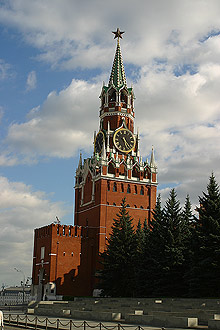|
 The Gothic-turreted Spasskaya Tower, considered by many to be the most beautiful tower of the Kremlin, was built under the supervision of Pietro Antonio Solari in 1491, and stands on the north-eastern side of the citadel, bordering Red Square.
The Gothic-turreted Spasskaya Tower, considered by many to be the most beautiful tower of the Kremlin, was built under the supervision of Pietro Antonio Solari in 1491, and stands on the north-eastern side of the citadel, bordering Red Square.
The gate of the Spasskaya Tower has been the official entrance to the Kremlin for centuries. Until the 17th century the tower was known as the Frolovskaya, due to its location not far from the St. Frol church and monastery. In 1658 an Icon of the Saviour was mounted above the gate facing Red Square, and the tower's name was changed to Spasskaya by decree of the Tsar.
The Russians have always regarded the Spasskaya Tower with great reverence. According to old legends, the tower was possessed with miraculous powers and was reputed to protect the Kremlin from enemy invasion. People passing through the gates would always observe the custom of crossing themselves and doffing their hats to show their respect, and horses passing under the gates of the tower were said to shy. In fact, legend has it that Napoleon himself could not prevent his horse from taking fright as he rode through the gates, having failed to show his respect, and the French Emperor's hat was said to have fallen from his head.
During the 16th and 17th centuries the tower was used by the Tsar and the Patriarch for ceremonial processions and for greeting foreign dignitaries, and even today world leaders on state visits are escorted through its gates on their way to an audience with the Russian President. The tower is crowned by an illuminated ruby-red star, which replaced the double-headed Russian eagle in 1937, raising the tower's height to 71 metres.
The tower is also famous for its chimes. The first clock upon the Spasskaya Tower appeared in the 17th century, after the addition of a multi-tiered turret to the top of the tower. Designed by the Englishman Christopher Galloway, the clock boasted gold numerals in Old Slavonic and Arabic upon a blue background decorated with silver stars, but it eventually broke and was replaced in 1707 with Dutch chimes.
The present-day Kremlin chimes were made in 1851-1852 by the Butenop brothers. During the October Revolution in 1917, a stray shell hit the clock, seriously damaging its mechanism. A year later it was repaired by order of Lenin, who decreed that it should be equipped with new chimes capable of playing the Communist Internationale. This unique clock has four dials, each 6.12 in diameter. The numerals are 0.72 metres in height, and the hour hand is 2.97 metres long, while the minute hand measures 3.28 metres. Their accuracy is ensured by a 32 kilogram pendulum. The ringing mechanism is equipped with 10 quarter-hour bells and one bell to chime the hour. The clock was originally wound by hand, but since 1937 it has wound itself automatically twice daily.
Today, just as 100 years ago, you can hear its ceremonial chimes, the sound of which rings out far beyond the surroundings of the Kremlin and Red Square below.
|

 The Gothic-turreted Spasskaya Tower, considered by many to be the most beautiful tower of the Kremlin, was built under the supervision of Pietro Antonio Solari in 1491, and stands on the north-eastern side of the citadel, bordering Red Square.
The Gothic-turreted Spasskaya Tower, considered by many to be the most beautiful tower of the Kremlin, was built under the supervision of Pietro Antonio Solari in 1491, and stands on the north-eastern side of the citadel, bordering Red Square.